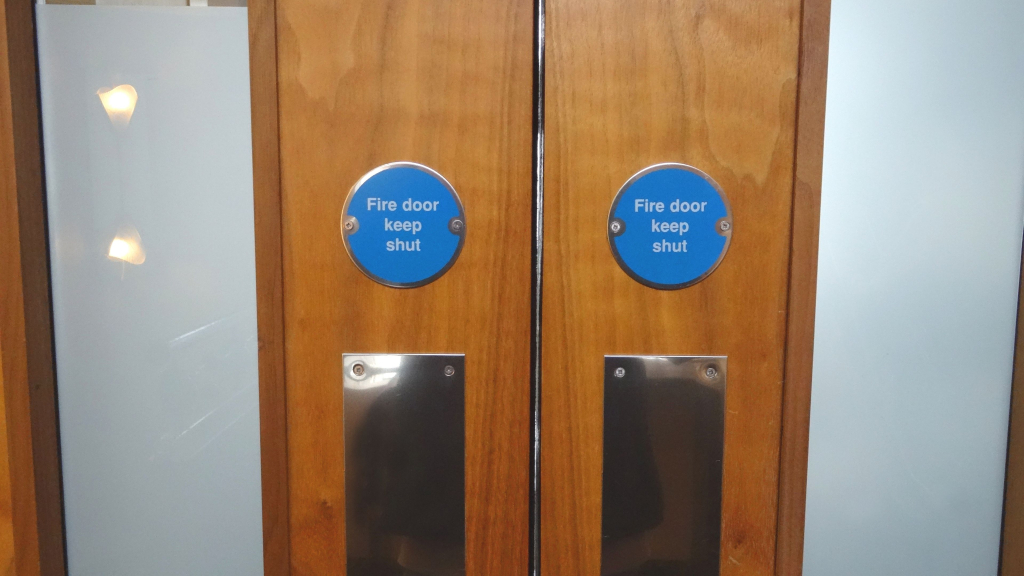7 doorway hygiene issues & solutions ~ SOFHT Conference
0 min read

7 doorway hygiene issues & solutions
The Tekta presentation at the Society of Food Hygiene and Technology (SOFHT) BRCGS conference then moved onto it’s final section, covering 7 common doorway hygiene issues. The goal of this part of the presentation was to raise awareness of these common issues and offer tangible solutions for delegates to take back to their businesses to help reduce the commonality of BRCGS Clause 4.4.8 non-conformances.
1. Gaps around doors
The first common doorway hygiene issue is a simple one, gaps around doors!
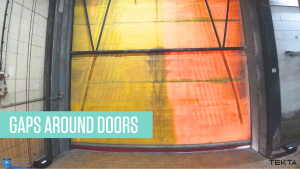
An obvious point? Yes! But a crucial one… Rodents are a significant risk to food safety, and external doors are one critical part of a food factory’s line of defence when it comes to preventing pest ingress. Gaps around doors are one point of entry for a rodent. (Remember, if you can fit a pencil through it, you can fit a mouse through it!). Light gaps are generally visible and easy to identify from the inside of a doorway.
There are 3 factors that cause gaps around doors. We’ll cover each off individually and provide practical solutions for each.
Gaps caused by doorway damage. Operations tend to move at a reasonable pace in food factories, and (as a result) there are certain parts of our facilities that are susceptible to damage. (Walls and doorways perhaps more than anything!) It’s important to know that a damaged door is highly likely to have changed in some way. This starts with the most obvious visible damage, to more subtle seal damage and panel or track misalignment. Any of these changes can create gaps, leaving the factory vulnerable to pest ingress.
There are two main solutions for maintaining a hygienic factory in spite of doorway damage. Firstly, daily checks. Including doorways on your daily hygiene checklist will help to ensure that you are able to stay abreast of any doorway damage as it happens. Secondly, doorway protection. There is a large range of doorway protection products available on the market including the the commonly know brands like A-Safe and the d-Flexx range by Warehouse Safety Solutions. Tekta also offer a range of complimentary doorway protection products, designed specifically for controlled hygienic environments.
Gaps caused by unlevel / damaged floors. Where floor levels differ across the width of a doorway, the door will close only to the point of the highest floor level, leaving gaps underneath the door elsewhere. In addition, damage to floor surfaces can often cause light gaps and potential ingress routes for rodents.
Similarly to doorway damage, adding doorways to your daily hygiene checklists will ensure any floor damage is identified, and corrective action undertaken swiftly. However, in some instances it is not easy to establish if a light gap is caused by the door or the floor. If this is the case, a word of advice given at the SOFHT presentation was to involve both your floor and door contractors early in the identification phase to avoid any differences in opinion.
Gaps caused by incorrect doorway specification. Not all doors are created equal when it comes to preventing pest ingress. Depending on the make and manufacturer of the door, some products like standard steel roller shutters are not always suitable for external food factory doors, due to their design. Finding yourself stuck with the wrong door is frustrating and can happen for 2 reasons. Firstly, incorrect specification of door chosen at point of purchase. And secondly, changes of factory layout. (Where non-production environments are adapted to production environments, the existing doorways may no longer be suitable for the area’s new function).
If you do find yourself with gaps caused by an incorrect doorway specification, one solution is to install retro-fitted seals. Rubber seals installed to the bottom of the door, and brush seals installed to door guides will effect a degree of pest proofing to the doorway. However, the main point raised at the SOFHT conference was for Hygiene teams to be actively involved in the selection and specification of new doorways. Doorways are a piece of new machinery to site and should undergo the same rigorous validation process as a new piece of production machinery.
When inspecting a doorway for light gaps, remember to check the side guides and top box of the door, not just the bottom seal (Mice and rats have an incredible knack for climbing!)
2. Gaps around docks
The second common doorway non-compliance raised at SOFHT conference was gaps around docks

A similar point to gaps around doors. Loading bays gaps are a direct route into a food factory for rodents. Generally caused by 2 main reasons.
Gaps caused by wear and tear. As shown in the photograph above, gaps around dock levellers are generally situated between the dock leveller platform and the supporting side angle. Dock levellers are usually supplied with either a brush or rubber seal between these two components, however, they are wearing parts. As the dock leveller is raised and lowered, the platform will rub against this seal and (over time) the part can be expected to become detached.
A solution for maintaining a hygienic factory in spite of loading bay wear and tear includes both regular checks and retro-fitted seals. Firstly, (as with door gaps) ensuring dock levellers are on the daily hygiene check list will mean any gaps are picked up on and corrective action effected immediately. Additionally, speak to your doorway maintenance provider to ensure dock leveller gaps are being identified and reported on your regular maintenance checks. Secondly, retro-fitted seals can be installed to re-close the gap.
Gaps caused by incorrect bay specification. Similarly to doorway gaps, an incorrect bay specification can be caused by two reasons. Firstly, incorrect specification at point of purchase. Secondly, changes in factory layout.
Again, the SOFHT conference presentation stressed the importance of Hygiene & Technical teams getting actively involved in the decision making (and validation) process of new machinery to site. This section of the presentation finalised by showcasing two example of hygienic loading bay products that allow for a complete hygienic door seal. The Prodok Loading House and the Prodok SLS.
3. Leaving doors open
The next common hygiene challenge raised was, leaving doors open.
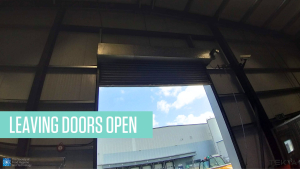
In some doorway scenarios, leaving a door open allows for better operational efficiency, particularly when moving goods in/out of the factory. However, as we know, external doors are critical for maintaining a pest-proof factory and leaving them open is a major risk. Leaving doorways open usually stems from two root causes.
Lack of operator knowledge / regard. Every food factory employee should be aware of the critical part they play in food safety and hygiene. However, this is not always the case, and often, keeping external doorways closed can be overlooked.
A key solution to this problem is education. The first step is to ensure that operatives using external doorways are aware of the important role they play in food safety. As a back-up precaution, audio alarms are a secondary solution. It is surprising how effective a 120dB siren can be in encouraging operatives to close a door! Sirens can be wired into a doorway so that they are activated after the door has been left open for a chosen period of time.
The second (and more common) reason is Impractically of doorway design. Where we have busy forklift traffic through a doorway, we have to ensure that the correct type of door is installed. For instance, where there is a roller shutter or sectional door with a slow operating speed, it would be impractical for operatives to close the door between each use.
The most effective solution to this problem is auto-closing doors. Some examples of these products are the Rapidor Impact, Rapidor Pro, or Rapidor Fold. These types of doors automatically close after a specified length of time, taking the responsibility of closing the door away from the operator, eliminating the need of human input. Additionally 2 doors can be installed in conjunction with each other to create an airlock, ensuring the doorway remains sealed at all time.
4. Dirt on top of doors
The fourth doorway hygiene problem raised at the SOFHT conference was, dirt on top of doors!
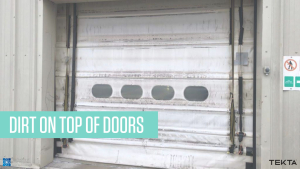
This part of the presentation discussed the issue of debris or water accumulating on the top of roller or sliding door headboxes. The top of roller or sliding doors are generally concealed with a metal casing, the top of which is typically flat. Where we have a messy production processes in the area adjacent to the door, debris can lodge on top of this casing (headbox). Alternatively, water from washing the area down can also accumulate on top of the doorway, causing both hygiene and mechanical issues to the door itself.
This point was covered to raise awareness of the issue and the following solutions were presented. Firstly, making the hygiene team aware of the issue and ensuring the tops of doors are cleaned and wiped down regularly. Secondly, take advantage of innovative doorway designs available on the market. 2 examples given were Tekta’s sliding door pipe-rail system and 15 degree angled speed door head box which prevents debris / water build up.
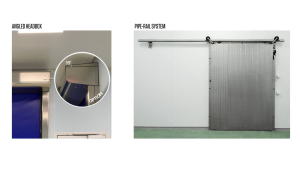
5. Curtains harbouring dirt
Next, the presentation covered the hygiene issue of dirt lodging onto door curtains and accumulating over time.
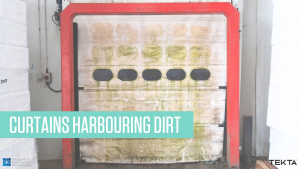
Although not such a well known hygiene issue, this can present a major hygiene concern.
Generally caused by spray from production processes, or from the floor, dirt and grime can build up on the shutter curtain. This generally takes time to occur, however, as it builds up over time dirt can fall from the door curtain, into product etc.
Solutions provided were to ensure door curtains are added to regular check lists and cleaning schedules for a simple wipe-down. Secondly, a word of warning was given about the hygienic design of high speed door curtains. Not all high speed doors are designed for food processing facilities. There are 2 types of PVC speed door curtain, firstly standard fabric and secondly, PVC coated fabric. Where standard fabric collects dirt more easily and is difficult to clean, PVC coated fabric is more resistant to dirt build-up and is easier to wipe down.
6. Dripping doors
Who knew? Dripping doors are a real doorway hygiene issue!

The Sixth doorway hygiene issue covered at the SOFHT conference was dripping doors. This issue is only relevant to roller doors and rapid rise doors.
When the door is in it’s closed position, the bottom seal is in direct contact with the floor. Any water or debris sitting on the floor may stick to the door seal at this point. When the door opens, this water / debris will fall from the bottom of the door seal. If a dolav is passing under the door at this time, the water / debris will fall directly into the product or ingredients, causing contamination.
Solutions given for this issue included alternatives to roller and rapid-rise doorway specifications. The first solution is a simple swing door for low traffic doorways, or bi-parting high speed doors for high traffic doorways. Both these doorway solutions open to the sides of the door opening, preventing water / debris contamination issues.
7. Emergency Response
The final hygiene issues raised was, emergency response.

Although this may not appear to directly relate to hygiene, a damaged doorway can have a direct impact on the food safety of a factory. This section of the SOFHT presentation encouraged the collaboration between hygiene and engineering teams, to work with their chosen doorway provider and create a contingency plan for each doorway on site. This involves considering the potential operational and hygiene impact of a damaged or non-functional door. Potential consequences could range from the more obvious external doorway damage causing a rodent ingress risk, to more complex situations which may require the rerouting of product through the factory.
Solutions presented at SOFHT included creating a contingency plan and ensuring doors are being regularly maintained to minimise the likelihood of doorway failure. Prevention is better than cure.
Helpful Links
Did you miss the Introduction to Tekta’s SOFHT presentation? Follow this link to see more.
Would you like to learn more about BRCGS and clause 4.4.8? Follow this link to one of our recent videos which explains the clause further.

